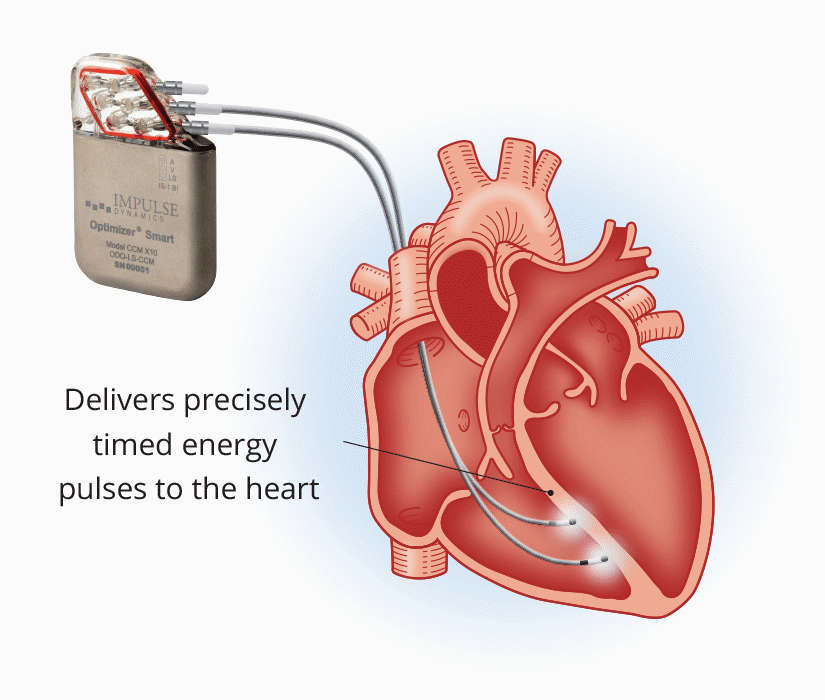
Use of Cardiac Contractility Modulation as Bridge to Transplant in an Obese Patient With Advanced Heart Failure: A Case Report
Daniele Masarone1*, Andrea Petraio2, Antonio Fiorentino3, Santo Dellegrottaglie4,5, Fabio Valente1, Ernesto Ammendola1, Gerardo Nigro6 and Giuseppe Pacileo1
- 1Heart Failure Unit, Department of Cardiology, AORN dei Colli, Monaldi Hospital, Naples, Italy
- 2Heart Transplant Unit, Department of Cardiac Surgery and Transplants, AORN dei Colli, Monaldi Hospital, Naples, Italy
- 3Impulse Dynamics Germany, Frankfurt, Germany
- 4Division of Cardiology, Ospedale Accreditato Villa dei Fiori, Naples, Italy
- 5Marie-Josee and Henry R. Kravis Center for Cardiovascular Health, Zena and Michael A. Wiener Cardiovascular Institute, Icahn School of Medicine at Mount Sinai, New York, NY, United States
- 6Department of Medical Translational Sciences, Monaldi Hospital, University of Campania “Luigi Vanvitelli,” Naples, Italy
Cardiac contractility modulation (CCM) is a novel device-based therapy in patients with heart failure with reduced ejection fraction (HFrEF). In randomized clinical trials and real-life studies, CCM has been shown to improve exercise tolerance and quality of life, reverse left ventricular remodeling and reduce hospitalization in patients with HFrEF. In this case report, we describe for the first time the use of CCM as a “bridge to transplant” in a young obese patient with advanced heart failure due to non-ischemic dilated cardiomyopathy. The patient had a poor quality of life and frequent heart failure-related hospitalizations despite the optimal medical therapy and, due to obesity, a suitable heart donor was unlikely to be identified in the short term and due to severe obesity risk of complications after implantation of a left ventricular assist device (LVAD) was very high.
Introduction
Most patients with heart failure (HF) with reduced ejection fraction (HFrEF) respond well to evidence-based pharmacological treatments and enjoy a good quality of life, with a significant prolongation of life (1). However, for reasons that are as yet unexplained, up to 10% of patients do not respond to pharmacological or non-pharmacological approaches, resulting in disease progression to the most advanced stage of HF (2, 3).
 The gold standard treatment option for patients with advanced HF is heart transplantation, or alternatively left ventricular assist system (LVAD) implantation as a bridge to transplant or as a destination therapy if a heart transplant is not feasible (2).
The gold standard treatment option for patients with advanced HF is heart transplantation, or alternatively left ventricular assist system (LVAD) implantation as a bridge to transplant or as a destination therapy if a heart transplant is not feasible (2).
Obesity is one of the most significant factors that strongly influence the management of patients with advanced HF (4). Indeed, for patients with end-stage HFrEF, obesity has been associated with modestly reduced survival after heart transplantation (5).
Therefore, the International Society for Heart and Lung Transplantation (ISHLT) guidelines consider BMI ≥35 kg/m2 to be a relative contraindication to heart transplant (6).
In addition, obese patients are more vulnerable to LVAD implantation due to their increased risks of post-procedural complications. In fact, in an analysis of 17,095 INTERMACS (Interagency Registry for Mechanically Assisted Circulatory Support) registry participants who received LVADs between 2006 and 2014, obesity was associated with higher risks of infection, device malfunction/thrombosis, cardiac arrhythmias, and hospital readmissions (7).
Cardiac contractility modulation (CCM) is a new therapy for treating patients with HF that improves the performance of the failing myocardium by delivering biphasic electrical pulses during the refractory period (8).
Here, we describe a case of advanced HF in a young obese patient in which CCM was successfully used as a bridge to transplant option, highlighting the efficacy and safety of this approach in selected patients with advanced HF.
Full article at: https://www.frontiersin.org/articles/10.3389/fcvm.2022.833143/full


